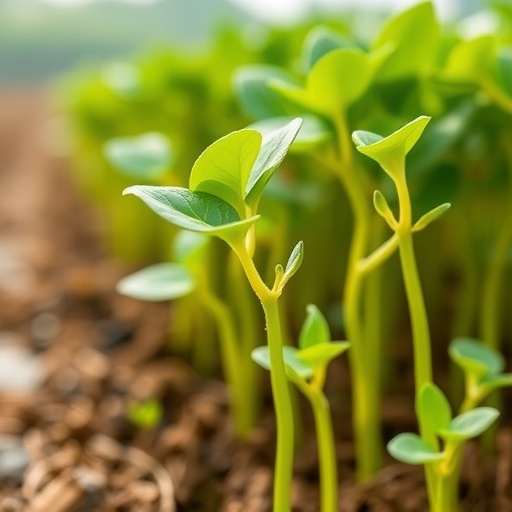In the ever-evolving quest for sustainable agricultural practices, a groundbreaking study recently published in npj Sustainable Agriculture has unveiled the transformative potential of leveraging microbiome-plant synergies to significantly enhance plant growth. The research, helmed by Zhao, Jia, Liu, and colleagues, delves into how microbiome-interactive traits within plants can be harnessed to boost productivity, resilience, and nutrient efficiency in crops. This new paradigm may well herald a revolution in how we approach farming in the face of escalating environmental pressures and global food security challenges.
Central to the study is the concept that plants do not exist as solitary organisms but rather as dynamic ecosystems intricately intertwined with diverse microbial communities. These microbiomes—comprising bacteria, fungi, archaea, and other microscopic entities—inhabit various niches on and within plant tissues. Their interactions, the study reveals, are far from incidental; they actively modulate plant physiology and growth in ways that can be exploited for sustainable advancement.
The researchers identified specific microbiome-interactive traits encoded in plant genomes that facilitate beneficial communication and cooperation with microbes. Importantly, these traits enable the establishment of symbiotic relationships that enhance nutrient acquisition by roots, promote resistance against pathogens, and increase tolerance to abiotic stresses like drought and soil salinity. Such traits represent a biological nexus where plant genetics and microbiome communities converge to generate emergent properties greater than the sum of their parts.
To elucidate these mechanisms, the team conducted multi-omics analyses combining genomics, transcriptomics, and metabolomics alongside extensive microbiome profiling. Their integrative approach allowed the identification of gene networks responsive to microbial signals. For example, regulatory pathways controlling root exudate composition, which chemically shape the rhizosphere microbiome, were shown to be pivotal in fostering microbial communities with growth-promoting capabilities.
Furthermore, the research highlighted how manipulation of these microbiome-interactive traits through breeding and genetic engineering can deliberately steer plant-microbe interactions toward beneficial outcomes. By selecting for plants that naturally recruit and sustain advantageous microbial consortia, farmers could reduce dependency on synthetic fertilizers and pesticides, mitigating environmental harm while maintaining or improving yields.
Beyond root-associated microbiomes, the study also explored phyllosphere (leaf surface) microbial communities and their functional impacts. Plants harboring robust microbiome-interactive traits were shown to maintain microbial compositions that bolster defense against foliar diseases and mitigate oxidative stress. This finding underscores the systemic nature of plant microbiome interactions and their pervasive role in plant health.
The implications of harnessing microbiome-plant synergies extend notably into climate resilience. Enhanced drought tolerance was observed in plants possessing optimized interactive traits, facilitated through microbial mediation that improves water use efficiency and osmoprotection. Such traits could be crucial in adapting crops to increasingly erratic weather patterns induced by climate change.
Crucially, the study’s insights challenge the long-standing reductionist view of agriculture that treats plants in isolation. Instead, it points toward a holistic framework embracing plants as meta-organisms within ecosystems where their microbiomes are integral components. This shift enables strategies that enhance ecosystem services, improve soil health, and promote biodiversity within agricultural landscapes.
In operational terms, incorporating microbiome-interactive traits into crop breeding programs demands sophisticated screening technologies and precise phenotyping methods. The authors advocate for the adoption of high-throughput sequencing and bioinformatics tools to identify marker genes linked to microbiome compatibility traits. Coupled with advances in synthetic biology, this opens avenues for the design of bioinoculants tailored to specific plant genotypes and environments.
Moreover, this approach aligns tightly with the principles of agroecology by prioritizing natural biological processes and reducing reliance on external inputs. It also offers a pathway to regenerative agriculture practices that restore soil vitality and foster long-term sustainability. The potential to produce crops with innate abilities to cultivate supportive microbial partners could revolutionize food production systems globally.
The intersection of plant genetics and microbiome science encapsulated in this work sets the stage for innovative agricultural biotechnology. By embracing the complexity and dynamism of microbiome-plant interactions, researchers and practitioners can tap into a largely untapped reservoir of biological potential. Scaling these findings from controlled environments to field conditions remains a research frontier but promises to reshape the future of farming.
As the global community grapples with the twin challenges of climate change and population growth, solutions grounded in ecological principles will become indispensable. This study delivers a compelling blueprint for leveraging the microbiome to enhance plant performance sustainably, offering hope for resilient food systems capable of meeting tomorrow’s demands without compromising planetary health.
Further, the study underscores the need for interdisciplinary collaboration spanning plant biology, microbiology, ecology, bioinformatics, and agronomy to translate fundamental discoveries into practical applications. Integrating microbiome-dependent traits with precision agriculture tools could optimize resource use efficiencies and minimize environmental footprints.
In conclusion, Zhao and colleagues illuminate a visionary pathway whereby harnessing the intrinsic synergies between plants and their microbiomes unlocks unprecedented potential in crop improvement. This represents more than just incremental progress; it signals a transformative shift towards agriculture that works in harmony with nature’s own microbial architects.
With ongoing advancements poised to refine our understanding and manipulation of these complex interactions, the agricultural sector stands on the precipice of a new age—one where microbiomes are no longer passive passengers but active partners in feeding the world sustainably and equitably.
Subject of Research: Harnessing microbiome-plant interactions to enhance plant growth and sustainability in agriculture.
Article Title: Harnessing microbiome-plant synergies: microbiome-interactive traits enhance plant growth and support sustainable agriculture.
Article References:
Zhao, T., Jia, X., Liu, X. et al. Harnessing microbiome-plant synergies: microbiome-interactive traits enhance plant growth and support sustainable agriculture. npj Sustain. Agric. 3, 50 (2025). https://doi.org/10.1038/s44264-025-00093-x
Image Credits: AI Generated




